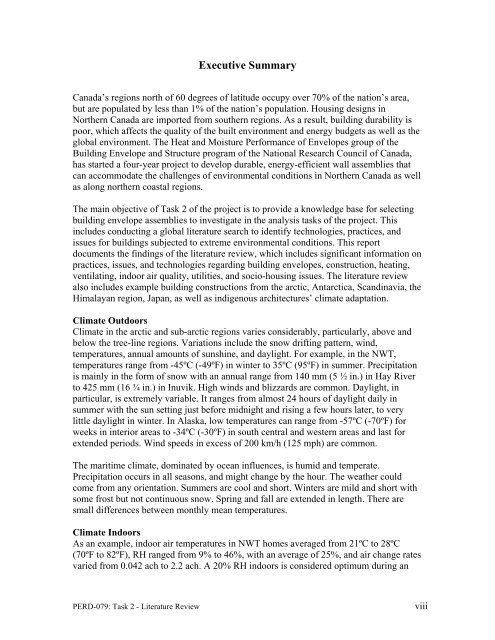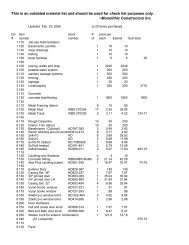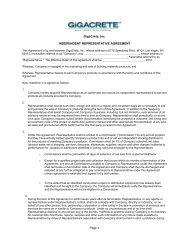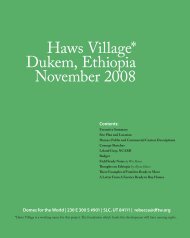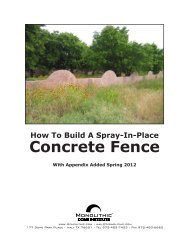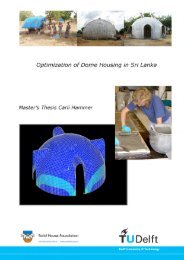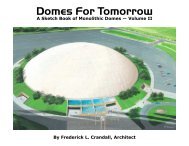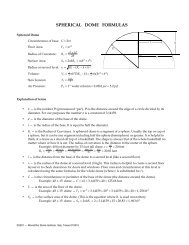Literature Review on Building Envelope, Heating and ... - Beeshive.org
Literature Review on Building Envelope, Heating and ... - Beeshive.org
Literature Review on Building Envelope, Heating and ... - Beeshive.org
You also want an ePaper? Increase the reach of your titles
YUMPU automatically turns print PDFs into web optimized ePapers that Google loves.
Executive Summary<br />
Canada’s regi<strong>on</strong>s north of 60 degrees of latitude occupy over 70% of the nati<strong>on</strong>’s area,<br />
but are populated by less than 1% of the nati<strong>on</strong>’s populati<strong>on</strong>. Housing designs in<br />
Northern Canada are imported from southern regi<strong>on</strong>s. As a result, building durability is<br />
poor, which affects the quality of the built envir<strong>on</strong>ment <strong>and</strong> energy budgets as well as the<br />
global envir<strong>on</strong>ment. The Heat <strong>and</strong> Moisture Performance of <strong>Envelope</strong>s group of the<br />
<strong>Building</strong> <strong>Envelope</strong> <strong>and</strong> Structure program of the Nati<strong>on</strong>al Research Council of Canada,<br />
has started a four-year project to develop durable, energy-efficient wall assemblies that<br />
can accommodate the challenges of envir<strong>on</strong>mental c<strong>on</strong>diti<strong>on</strong>s in Northern Canada as well<br />
as al<strong>on</strong>g northern coastal regi<strong>on</strong>s.<br />
The main objective of Task 2 of the project is to provide a knowledge base for selecting<br />
building envelope assemblies to investigate in the analysis tasks of the project. This<br />
includes c<strong>on</strong>ducting a global literature search to identify technologies, practices, <strong>and</strong><br />
issues for buildings subjected to extreme envir<strong>on</strong>mental c<strong>on</strong>diti<strong>on</strong>s. This report<br />
documents the findings of the literature review, which includes significant informati<strong>on</strong> <strong>on</strong><br />
practices, issues, <strong>and</strong> technologies regarding building envelopes, c<strong>on</strong>structi<strong>on</strong>, heating,<br />
ventilating, indoor air quality, utilities, <strong>and</strong> socio-housing issues. The literature review<br />
also includes example building c<strong>on</strong>structi<strong>on</strong>s from the arctic, Antarctica, Sc<strong>and</strong>inavia, the<br />
Himalayan regi<strong>on</strong>, Japan, as well as indigenous architectures’ climate adaptati<strong>on</strong>.<br />
Climate Outdoors<br />
Climate in the arctic <strong>and</strong> sub-arctic regi<strong>on</strong>s varies c<strong>on</strong>siderably, particularly, above <strong>and</strong><br />
below the tree-line regi<strong>on</strong>s. Variati<strong>on</strong>s include the snow drifting pattern, wind,<br />
temperatures, annual amounts of sunshine, <strong>and</strong> daylight. For example, in the NWT,<br />
temperatures range from -45ºC (-49ºF) in winter to 35ºC (95ºF) in summer. Precipitati<strong>on</strong><br />
is mainly in the form of snow with an annual range from 140 mm (5 ½ in.) in Hay River<br />
to 425 mm (16 ¾ in.) in Inuvik. High winds <strong>and</strong> blizzards are comm<strong>on</strong>. Daylight, in<br />
particular, is extremely variable. It ranges from almost 24 hours of daylight daily in<br />
summer with the sun setting just before midnight <strong>and</strong> rising a few hours later, to very<br />
little daylight in winter. In Alaska, low temperatures can range from -57ºC (-70ºF) for<br />
weeks in interior areas to -34ºC (-30ºF) in south central <strong>and</strong> western areas <strong>and</strong> last for<br />
extended periods. Wind speeds in excess of 200 km/h (125 mph) are comm<strong>on</strong>.<br />
The maritime climate, dominated by ocean influences, is humid <strong>and</strong> temperate.<br />
Precipitati<strong>on</strong> occurs in all seas<strong>on</strong>s, <strong>and</strong> might change by the hour. The weather could<br />
come from any orientati<strong>on</strong>. Summers are cool <strong>and</strong> short. Winters are mild <strong>and</strong> short with<br />
some frost but not c<strong>on</strong>tinuous snow. Spring <strong>and</strong> fall are extended in length. There are<br />
small differences between m<strong>on</strong>thly mean temperatures.<br />
Climate Indoors<br />
As an example, indoor air temperatures in NWT homes averaged from 21ºC to 28ºC<br />
(70ºF to 82ºF), RH ranged from 9% to 46%, with an average of 25%, <strong>and</strong> air change rates<br />
varied from 0.042 ach to 2.2 ach. A 20% RH indoors is c<strong>on</strong>sidered optimum during an<br />
PERD-079: Task 2 - <str<strong>on</strong>g>Literature</str<strong>on</strong>g> <str<strong>on</strong>g>Review</str<strong>on</strong>g><br />
viii


